No, Michael Moore is not simply the next older gentleman who suddenly loses his empathy and drifts into the world of alternative facts. This case is more complicated, even almost mysterious. One knows Moore through movies like Bowling for Columbine and Fahrenheit 9/11, books like Stupid White Men or Downsize This!. He still calls himself a leftist and environmentalist and is now involved in a film that doesn’t really reflect this.

This film is called „Planet of the Humans“, the directing and script are not by Moore himself, but by his longtime friend Jeff Gibbs, who in turn is listed as co-producer on many of Moore’s films. But this shouldn’t diminish Moore’s role, for him this work is not just any job, but an important statement. He advertises it with talk show host Stephen Colbert and on the day of release he put an almost 80-minute, very personal livestream on the Internet to mark Earth Day. Watching these shows, one thing quickly becomes clear: Moore seems to be absolutely convinced to support the environmental movement, and explicitly Fridays for Future, Extinction Rebellion etc. with this film.
He couldn’t be more wrong, because the central message of the 100-minute documentary is that there are currently no solutions to the climate catastrophe and that we are all actually lost. Now there are a lot of possible solutions and almost all of them include an energy transition in which we replace fossil fuels with climate-neutral alternatives. These alternatives are quite wrongly presented in the film as pointless in general, because all its central thoughts are based on the same fundamental error of reasoning: The inability to distinguish between greater and lesser evils.
The principle that we strive for improvements, even if they are not perfect, is the basic idea behind all our progress. If people had waited for the discovery of the perfect, 100% side-effect free vaccine, we would have millions of smallpox and measles deaths in Europe. If they had been thinking in this way, they would probably also have abandoned the three-way catalytic converter, because it does filter a lot of pollutants out of a car’s exhaust gases, but not all of them. And although there is no contraceptive with a Pearl index of 0, the manufacturers enjoy good sales.
This is not to say, of course, that these improvements are above criticism. Rather, a contribution to the question of which improvements, if you look at them in detail, are actually just greenwashing campaigns that try to ride the wave of climate protection without making any real contribution would come at exactly the right time. This is probably also the basically honourable motive of Gibbs and Moore, who, however, hopelessly overshoot this goal: Instead of doing real research, they simply rehash their own ten-year-old theories:
Many claims come from co-producer Ozzie Zehner, who is simply introduced in the film as a „visiting professor at the University of California“ who is ostensibly not involved in the film. He has already written very similar claims in his book „Green Illusions: The Dirty Secrets of Clean Energy and the Future of Environmentalism“ from 2012. Director and screenwriter Jeff Gibbs had already written down other central statements of the film in a Huffington Post article published in 2010, in which he quite justifiably criticises certain US biomass power plants, but then increasingly slips into positions of climate denial.
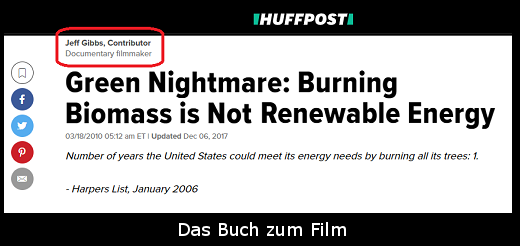
Yes, in 2010, which is the second big problem of this film: Most of the statements are based on data from 2008 to 2012 – and I only know this because I have checked it, the film itself does not give any information about it. Since that time, however, there have been downright revolutionary developments in the sectors of photovoltaics, wind power and electricity storage. A film released in 2020, which has failed to take into account all these developments, seems as absurd as if someone had written a long treatise in 2000 about the limited potential of mobile phones and would now publish it in a major publication, even though it does not include the concept of modern smartphones.
The result is a Jeff Gibbs who is hopelessly overwhelmed with the subject matter and spends an entire length of feature film asking the wrong people the wrong questions about the most important issue of our time without comparing the answers to the year 2020. There is so much blatant nonsense in it that I would love to print out a transcript and mark all the mistakes in red. But since no one would seriously want to read that, I will now refer to the most absurd parts of the film in my eyes and write a more complete list for those who are interested over the next few days.
In general, the maker does not seem particularly familiar with the topic by repeatedly referring to the word „green“, which he also adopts into his own vocabulary. The fact that any company is now „producing green“ is usually a phrase from their PR flyer or the tabloid press. In a serious film about energy concepts, you should say what you mean in specific terms. Products can be climate-neutral, they can be sustainable, they can be biodegradable, use water and land carefully, be produced under fair working conditions and so on.
It is particularly misleading that not even the operators of the criticised „green“ technologies themselves claim to be particularly „green“. For Jeff Gibbs to take action, a small harmless article by NBC News in 2005 about a zoo in New York State wanting to use the excrements of its elephants to provide electricity is enough. This would save him the cost of disposal and reduce his electricity bill, according to the plausible plan, for which the article said a study should be started.
Now the filmmakers claim that the resulting current would not even be enough for the elephant pen due to a lack of sufficient manure. Maybe, if the study came to this conclusion, but what does it prove? Saving a little energy is better than not saving energy at all. Nobody has claimed that it is possible to organise significant parts of the US energy supply using elephant dung – at least I hope so. So it would be interested to hear what the study came up with in the end. Unfortunately we don’t get to know anything about that in the film, instead we see the presumably at least eight years old interview material with a few zookeepers at 21:25.
In the same manipulative way, the alleged weaknesses of solar power are „exposed“: In minute 06:56 Gibbs visits the Sunweaver Festival, a kind of music festival whose organizers focus on the potential of solar power and also generate solar power for the festival itself. He then observes how the technicians switch on biodiesel generators and conventional grid power during a downpour in order to keep the stage equipment running, thus revealing in his own interpretation the futility of the use of solar power. At no point do we learn whether the festival has ever claimed to be able to supply itself with 100% self-sufficient electricity, and more importantly, whether it would not have been technically possible to achieve such self-sufficiency in any other way.
It would, of course. On stage (seen at minute 7:27) there are estimated up to 10 normal sized concert loudspeakers and monitor boxes, light effects are not visible at all. In a small concert hall today, with the appropriate efficient equipment (e.g. LED lights), you can provide sound to 1000 people and the power consumption would be around 9 kilowatts. Theoretically, the battery of a single fully charged Tesla Model 3 could cover this over five and a half hours. The homepage of the Sunweaver Festival also doesn’t look like the website of a money floating organization that could afford a large power storage unit 10 years ago, but like the work of a few idealists.
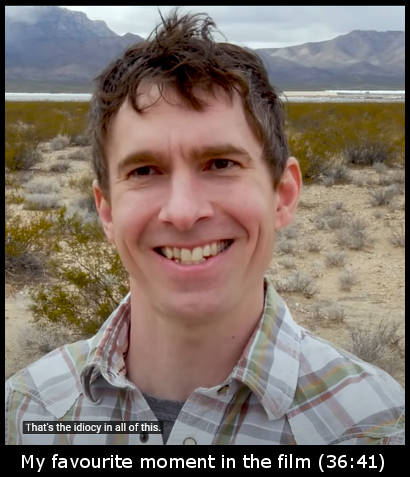
Anyone interested in the truth could have asked the operators. Alternatively, there are thousands of people around the world who are doing research in this area and could certainly have given Jeff Gibbs a more competent answer than a couple of busy stage technicians from 2012 (or earlier). This concept, however, is the common denominator that runs through this film: We watch Jeff Gibbs being confronted, seemingly by chance, with the most absurd excesses of „green“ technology, only to discover with astonishment that „green“ does not always mean useful or even sustainable.
Starting at minute 11:47 Jeff Gibbs tells us how he was attending General Motors‘ press conference in the (presumed) year 2010 to present the company’s latest hybrid vehicle and promising newcomer, the „Chevrolet Volt“. While the Volt is now being charging in a press-effective manner at the company’s own parking lot socket, there are all kinds of funny moments when the GM personnel on site reveal their cluelessness about sustainability. Those don’t know exactly how electricity is produced, think that „Natural Gas“ is climate-friendly, apparently because of its name, and say things like „I don’t think coal is bad“, „[coal] has lovely energy values“ (minute 13:45).
Yes, that is all very entertaining, but this is also a car company that still generates by far the most turnover with combustion engines. Those who expect the representatives to be experts or even advocates of the energy transition will probably also ask his butcher for vegan recipes. In addition, the film team could not have been satisfied anyway, because now that the high proportion of coal in Michigan’s power grid has been made fun of, the production of solar power is subsequently criticized.
In 2008, Lansing (capital of the state of Michigan), launched a project that was revolutionary by US standards at the time and had solar modules installed for 600,000 US dollars. Just to remind you, 2008 was a time when Michael Jackson was still alive and George W. Bush was president of the USA. Or in other words: That was a pretty long time ago. So long that end customers had to pay over 4,000 Euros per kilowatt peak at that time. Today, we are just over 1000 Euros per kilowatt peak, also because we hardly ever use amorphous silicon cells for such systems, which the solar array shown in the film is equipped with.
Amorphous solar cells today are something like the red wine from Tetra Paks. It tastes mediocre, yet somehow makes you drunk, a big portion of headache and is nice and cheap. So the city of Lansing would have to pay only about 20,000 US-Dollar for the modules of this plant today, adjusted for inflation. Probably they would not use the Tetra-Pak solar cells anymore, but crystalline cells that can generate many times more electricity (spoiler: they do).
In the film, a guide leads through the solar plant and states that it generates 64,000 kilowatt hours of electricity per year. To put it in context: this is what about 20 German households consume per year. In the film, the operator’s employee then explains that a system that could supply the entire city would have to cover almost 15 square miles. The message is clear: In everyday practice, this technology can never supply enough energy for our needs.
You may have come to that conclusion in 2010, but a lot has happened since then.The guide mentions an efficiency of less than 8 percent for the entire facility and jokes that very efficient cells can only be used on NASA space probes because they cost a million dollars per square inch. It’s hard to tell in retrospect exactly what he meant by „very efficient“, but common solar cells for the domestic market already have an efficiency of 15 to 22 percent, which is about two to three times higher.
In the meantime, the solar array in Lansing has also been upgraded: you can see on Google Maps that the lower part of the array has been expanded with new cells, and this alone means that the plant generates 150,000 kilowatt hours annually now, about two and a half times the amount claimed by the outdated film material. So if you wanted to supply the entire city with solar power, you would only need a fraction of the 15 square miles mentioned in the film, just by using current technology.

In addition, it would not be necessary to place these cells in areas exclusively reserved for them, as the film implies, because in Lansing, as in most US cities, there are so many parking lots and commercial areas that the city center looks like a gigantic white-gray lump on the satellite image. GM’s local car factory alone covers an area of 0.8 square kilometres with its parking spaces, which would be enough to supply 11,000 German households with electricity using photovoltaics.
This is not exactly groundbreaking news for Europeans – solar cells are primarily seen on the roofs of houses or other existing structures, so why don’t the Americans do the same? Surprise, that’s exactly what they’re doing: Since February of this year, 670 meters by 670 meters of parking space (equivalent to one eighth of Central Park) at Michigan State University in Lansing have been equipped with modern solar cells. Together with the Delta Solar Plant in the southwest of the city, which was commissioned in 2018, and the small plant that can be seen in the film, almost 10,000 houses in Lansing can then be supplied with solar power.
The whole story, which the film tries to tell so smugly, is shattered here by the reality of the year 2020 like a DeLorean on a locomotive from 1985. That‘ s because photovoltaics simply work nowadays. But the film also finds a problem for this solution: How are solar cells manufactured? This is how the film creates its very own license to complain forever. First it asks how much solar power there is in Lansing – little? Oh, that is bad. And if municipalities multiply their solar power? That’s not good either, because solar cells do not grow on trees.
From minute 36:51 onwards, we see the central montage of the film, which in my opinion is the most flattering disinformation in a film full of flattering disinformation, starting with „How Solar Cells & Wind Turbines are Made and electric cars too! (sic). For two minutes and 16 seconds we are bombarded with images to disturbingly disharmonic music. In a sequence of extremely short cuts, they show scenes of global mining, factory buildings, smelting processes, chemical sum formulas and terms, industrial plants, African children in cobalt mines, laboratories, coal spoil tips, oil rigs, robots in a Tesla factory, steelworks and blasting processes. There are also short insertions such as „Hexafluoride 23,000 times worse than CO2“ or „concrete – third leading cause of co2 emissions“, others cannot be read at all, they are probably just supposed to provide a diffuse feeling of fear.
You suddenly ask yourself if you are still watching the movie of a left-wing environmentalist or if you somehow got diverted into a disgusting propaganda show of the Trump administration. ultra conservative populists, the oil lobby, Russian natural gas billionaires, and coal and nuclear power plant operators will cheer on this segment, which tells the uninitiated viewer that renewable energy destroyed the planet worse than all other technologies combined.
It seems highly superfluous to write it explicitly here, as if I would explain that the road gets wet during rain, but: No. No, solar cells, wind turbines and electric cars do not cause more environmental destruction than their fossil alternatives. On the contrary, their impact over the entire life cycle is a fraction of that. They produce fewer greenhouse gases, require less land area and also much less raw materials. This was obvious even with data from 2007.
Yes, wind turbines are not made by some magical elves in a pretty clearing out of fir cones, but in a factory made of concrete, steel and composites. Anyone who doesn’t like that either, has to completely cut back on power consumption – and I have strong doubts about our two protagonists Jeff and Michael, whether they would be good role models for this goal. After all, they are shooting a film with the use of lots of fossil fuels, which is pillorying new, more sustainable technologies while not mentioning any of the disadvantages of the status quo.
After all, if someone were to make such a montage for the production and operation of coal-fired power stations, oil tankers and gas pipelines, one would actually have to reuse the entire footage, enhanced by shots of exploding oil rigs, forests cleared to lunar landscapes for oil sands, oil spills in rainforests and twenty times the playtime to match the ratio.
If any of the people involved in the film had taken the effort to quantify this damage exactly, they would have noticed. Instead, in a collective panic attack, the makers seem to have forgotten that all these issues are actually about not exceeding the planetary boundaries. A look at the figures gives an idea of the technology that is most likely to achieve this.
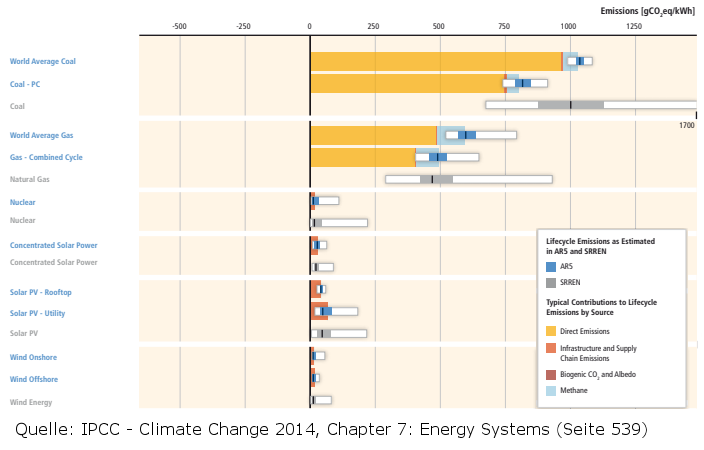
Yes, we are currently in the unfortunate position that the production of solar cells and wind turbines also emits greenhouse gases because our entire economic system is based on the burning of fossil fuels. But a look at the diagram also shows that even in this situation, electricity production with wind and solar power causes a tiny fraction of the emissions of a gas or coal-fired power plant. Nevertheless, the film repeatedly claims that photovoltaic and wind power are as bad (minute 24:41) or even worse than coal or gas power (minute 19:02).
The magic word is transition: the more energy produced sustainably in our grids, the better the climate footprints of all products manufactured with it – including solar cells, wind turbines and electric cars. Nothing in the production process relies on burning prehistoric plants; they were just the apparently cheapest energy source for electricity and heat for a long time. It is possible to change all areas of our lives to zero or even negative climate emissions, but not all at the same time and not within a few days.
Therefore, it is grossly misleading if the montage mentions, of all things, the nature-destroying oil and coal production as an argument against solar and wind power. Yes, currently some oil and coal is also being burned for this sector, but only due to the lack of a completed energy transition and with the explicit goal of completely phasing out these energy sources.
To crown it all, this ill-conceived piece does not present a single solution at the end, except: Our eternal economic growth must end, we must stop overpopulation, we all have to look sadly at cameras and cry.
Sorry, but that’s just embarrassing. Yeah, unlimited growth on a limited planet can’t work. Yes, you can criticize how some places feed electricity into the grid using the generic term biomass, but even if aliens beamed 4 billion people away from Earth by tomorrow and we imposed 20 years of climate protection lockdown measures on the global economy, it still needed energy and resources, albeit less.
People also have to eat in a different economic system, they have to live somewhere, somehow heat their living space and somehow get from one place to another. Instead of 37 gigatons of CO2-eq. per year, we would then perhaps only emit 10 gigatons of CO2-eq. per year, but that would only postpone the climate collapse a little. Presumably, the movie wants to point out that new technology alone will not save us if we don’t limit ourselves as well. I would agree with this, but unfortunately it also applies the other way round: without another, more sustainable technology, restriction alone will not save us.
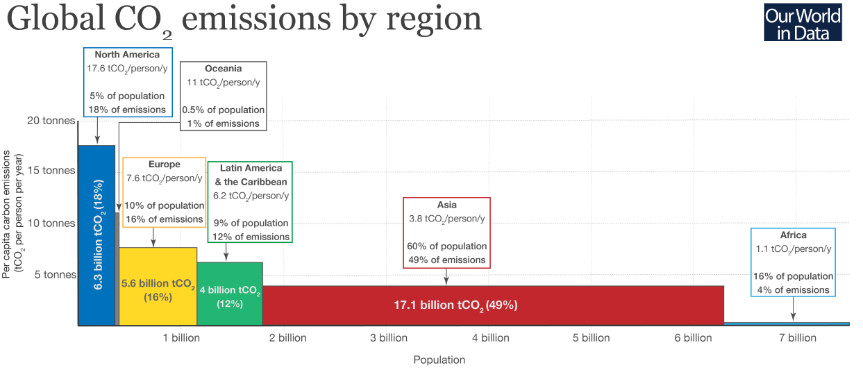
However, for Jeff Gibbs and Ozzie Zehner, all proposed solutions that do not have zero environmental impact are unacceptable. Regrettably, this is completely naive; even tribal peoples living in the savannah have an impact on the nature surrounding them. Before the arrival of mankind, Germany was almost completely forested; even small, certified organic potato acres represent an encroachment on this ecosystem, with man claiming these areas and resources for himself. Those who cannot accept this for themselves can actually only choose suicide – but please not with a burial, a coffin consumes a lot of wood. A jump into the sea with biodegradable weights on the feet should be the obvious choice.
The constant reference to overpopulation is similarly absurd. The growth of the world’s population has been declining since the 1960s (note: the growth itself, not the population) and there are hardly any ethically acceptable concepts, apart from the spread of education and equal rights, to effectively accelerate this process. The total population is also growing because people in emerging countries are now also getting older and older. So even if no one had children in the next 10 years, our resources would have to be sufficient for many billions of people.
Moreover, the vast majority of climate emissions do not take place in the countries with the largest population growth, but in rich societies with stagnating populations. There is something quite obnoxious when a film, in which almost without exception older, white men have their say, tells tales about the dangers of overpopulation. Sadly, a lot of people understand this as: „Asians and Africans are so numerous, they need to get fewer.“
Not surprisingly, ultra-right media such as Breitbart (I don’t link) are extremely positive about the film. The makers of German-speaking equivalents are thrilled about the exposed „green lies“ and see it as proof of the hypocrisy of the environmental movement. Both the narrative of uncontrolled proliferation of people in poor countries and the positions from the climate denial movement have long been a popular topic of discussion.
Conclusion:
We are dealing with a highly manipulative movie. Neither the film itself nor the accompanying media provide valid sources for the many, many steep claims. Instead, the director uncritically adopts the personal opinions of those interviewed. Among them are the co-producer (who studied engineering), several anthropologists, a sociologist, an ecologist, an environmental sociologist, a psychologist, stage technicians, wind energy opponents, zookeepers and employees of various companies such as General Motors. The movie does not make any effort to educate us on what the most knowledgeable people in science and research have to say about all this.
If any specific data are shown at all, they are distorted by a lack of context and inadequate references such as „Source: International Energy Agency“ (minute 30:43) or „Source: German Federal Government“ (minute 34:03) or they relate to ancient studies from 2012 whose central basic assumptions no longer apply today (minute 22:42). In general, we as viewers are completely kept unaware of the chronological sequence of events. However, the film and also the deliberately chosen time of publication imply that its statements are absolutely relevant here and now.
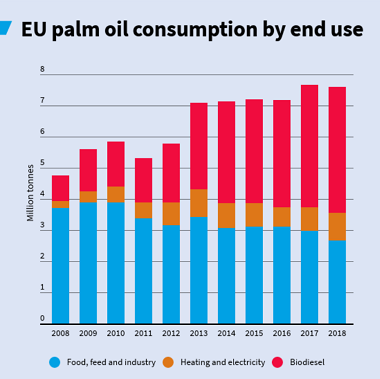
Yes, one should also look at companies that claim to be „green“ and see what this means in specific terms. Yes, there are biomass power plants whose operation is ecologically questionable. The creators were probably driven by the fear that heavy industry would now turn away from coal and oil combustion, only to cover the country with forest-destroying biomass power plants.
Michael Moore represents strong left-wing positions, among other things he is a critic of large corporate structures and in his time as an environmentalist he had to witness how the environmental movement in his home state of Michigan lost one fight after another against politically tied large corporations. He probably now dreads the fact that his old enemies simply trade one technology for another and everything else continues as before.
The truly tragic side of this is that Moore and Gibbs dramatically stand in their own way here, because no technology is better suited to decentralized energy supply than renewable energies. There are districts in Germany today that are already self-sufficient in energy supply. Whole states could free themselves from dependence on energy imports and if you are customer of the most successful German CO2-compensation firms, they often invest in ecologically reasonable, small biogas plants in Nepal, India or Kenya, because there are cow dung or crop residues anyway.
But instead of making such projects a worldwide standard, Moore and Gibbs are telling a story here that the big power companies could not have come up with better themselves, thus consolidating their power even more. To somber music and out-of-context images, Jeff Gibbs‘ monotonous voice constantly proclaims that it has discovered something sensational. „We found out“, „We discovered“, „but the truth was“, art pause, recording of a power station, interview with crying woman at the lake, and there you have the sensation.
The last sequence consists of three minutes in which we witness in agonizingly slow settings the indeed unbearable fate of an orangutan specimen whose habitat is being destroyed. Such rainforest clearings are primarily carried out in their habitat on Borneo and Sumatra to produce palm oil. However, this is not used to produce solar cells, wind turbines or electric cars – the majority of European palm oil imports end up in a technology that, according to the film, we should not replace with electric drives: our combustion engines.
More than 10 million litres every day, in Europe alone. It is time to change that.
________________________________________________________________________________
This article would not have been possible if all the nice people at Patreon, Steady, Paypal or in any other way did not support me. In order for the author to write more articles without starving to death, you can donate one Euro or Dollar to him here. He would be very grateful and happy to mention you by name (if you want to do so).
In this spirit I would like to thank my donors
Andreas Bär Läsker, Alexa Marie Erni, Alexander Schulz, Alexandros Tamtelen, Andreas Grüner, Andreas Wojtkowiak, Andreas Zientarski, Anja RiFa, Anja Sittig, Anna Manow, Anna-Christina Nguyen-Khac, Annett Förster, Antje&Marcus Guttenberger, Attila Beke, Barbara Lechner-Mlnarschik, Barbara Sempell, Bastian Döen, Ben Martin Mueller-Zermini, Bettina Hövener, Björn Völkel, Caba Kroll, Christian Maas, Christian Mann, Christian Marchner, Christian Pfeiffer, Daniel Haas, Daniel Richwien, Daniela Knott, Daniela Vaak, Denis Zick, Dennis Kubon, Derik Meinköhn, Dominik Lunz, Doreen Propp, Dorothea Böhnke, Elisabeth Gruber, Elisabeth Huber, Erik Bauch, Felix Kolk, Felix Sprick, Frank Schönherr, Frank Tengler-Marx, Frank Wisniewski, Gabi Quotschalla, Gabriele Bartolomeo, Gronkh, Harald Stey, Heidi Liesch, Heidrun Grüttner, Hermann Kastner, Hilke Larsen, Jannik Olbrich, Jannik Rulitschka, Jens Musleh, Jessica Gerhards, Joël Daniel, Jonas Bartkowski, Julia Kugler, Jürgen Wondzinski, Jurij Wölfling, Karsten Zapp, Katja Cordts-Sanzenbacher, Kelz Reinhard, Kevin Watzal, Lars Rafeldt, Lea Kleineberg, Malte Nottmeyer, Manuel Eisenreich, Marco Zeps, Markus Schmid, Martin Dejonge, Martin Gertler, Martina Gruber, Mathias Hohn, Matthias Rinne, Melina Rauch, Michael Henning, Michaela Müller, Nikolaus Reuss, Oliver Schmitt, Pat Mächler, Patrick Hundt, Peter Martiensen, Peter Schleßelmann, Philippe Jaeck, Rick Assmann, Robert Gabel, Sandra Matus-Leypold, Sascha Röwer, Sebastian Halles, Sebastian Scobel, Sebastian Weißenseel, Stefan Dauck, Stefanie Rückert, Steffen Kaltschmid, Steffen Wittke, Stephan Schwarz, Svenja M, Thilo Pfeil , Timo Taege, Urs Fürer, Uwe Mateja, Vidroflor GmbH Georg Maes, Volker Hackmann, Walter Danner, Werner Rotz, xaver fischer
I would also like to thank all other donors no less deeply:
Aileen Wessely, Alex DaZbert, Alexandra Arnold, Alexandra Diez, Alexandra Janssen, Alexej Stephan Creutz, Aljoscha Collet, Almut Riese, Alois Lipsky, Alyce von Rothkirch, Ana Wolfelschneider, Andre Zerbe, Andrea Bindrich, Andrea Finas, Andrea H., Andrea Maurer, Andreas Plath, Andreas Uhlenhoff, Angela Fahrenschon, Anika Stümpel, Anja Donning, Anja Frieda Parré, Anja Gutschmidt, Anja und Bernhard Malle, Anja Wenke, Anna Hanisch, Anna Wieser, Anne Christin Brück, Anne Grabinsky, Anne-Marie Wijnants, Annika Stawicki, ARGENKRAFT e.K. / Martin Schmitt, Astrid Rosenberger , Astrid Puchinger, Astrid Tuchen, Axel Siepmann, Baar, Michael, Barba Ra, Barbara Götz, Bastian Krause-Heiber, Bastian Reitmeyer, Be Schneider, beate hadwiger, Benedikt Doenhoff, Benjamin Junghans, Benjamin Schütte, Bernd, Bernd Fasching, bernd haller, Bernd Hans Müller, Bettina Schröder, Beyond Dystopia, Bjoern Schneider, Björn, Blandine Schillinger, Boris Gnielka, Carina Nowak, Carmen Radeck, Carmen Schirling, Carmen Thelen, caro, Caroletta, Caroline Greiner, Caroline Hühn, Carsten Kraus, Cassandra Derreza-Greeven, Christian Heep, Christian Kaufmann, Christian Mann, Christian Minet, Christian Pelzer, Christian Schade, Christiane Bärsch, Christiane Bergner, Christina Albert, Christina Hiller, Christina Jubt, Christina Stacke, Christine Fiedler, Christine Frei, Christoph Sahm, Christopher Lang, Christopher Siefke, Claudia Beck, Claudia Bosch, Claudia Kneip, Claudia Petschull, Claudia Rinne, Clemens Schröder, Constance Kretschmann, Cornelia Waibel, Damiano Miceli, Daniel Hinkelmann, Daniel Just, Daniël van den Bergh, Daniela Greiner, Daniela Hoppen, Daniela Ott, Daniela Rilling, David Frank, David Jaworski, Denise, Denise Rupprecht, Detlef Menke, Diana Diansen, Diana Sauerwein, Dinter Jörg, Dirk Beichert, Dirk Michael Mumot, Dominik Benjamin Pauli, Doris Kolb, Dorothee Lindenbaum, Dr. Manfred Kutzke, Eckhard Lucius, Elias Röring, Elisabeth Penning, Elisabeth Pietraß, Elke Düzgün, Elke Schneider, Eric Kiel, Erik, esther michaelis, Esther Weiß-Fenner, Fabian Michael, fabian sessler, Felix, Felix Allmann, Felix Mengi, Felix Schulte, Femke Hustert, Florian Beckmann, Florian Escherlor, Florian Klett, Florian Moser, Florian Spensberger, Florian Steffen, Florian Thurner, Florian Wagenhuber, Florin Schaffner , FoxTel GmbH & Co. KG, Frank Gaertner, Frank Silkeit, Frank Simons, Franz Anneser, Franz Gutwein, Irmgard Gutwein, Franziska, Franziska Angene, Franziska Held, Gabriele Speiel, Ge Lu, Gerald Dehn, Gero Wierichs, Gloria Bauer, Gregor, Gregor Galic, Gregor Nathanael Meyer, Grischa Stuer , Gunnar Lott, Hani Fischer, Hannah fa, Hannes Stachelhaus, Hanno Endres, Hans Rudolf Schläfli, Hauke Klement, Heike Bäumer, Heike Heuser, Heike Linnek, Heike Siegler, Heinz Ruffieux, Heinz-Jürgen Hartmann, Helene Ludwig, Hendrik Viehl, Henning Groß, Henning Schillmoeller, Horvath-Fürer Christ, Ideenkiste, Ilka Fründ, Ines Thull, Ingo Neumayer, Inka Roselieb, Inna Janssen, Irene Johanna Hallof, Irene Nowotny, Irina Schwenk, Irmi, Isabelle Tesche, Ivan Ovinnikov, Jan Kurella, Jan Prause, Jan Schulz, Jan Wiegand, Jana Beyer, Jana Locher, Jana Skibba, Janina Fuchs, Janine ProNobi, Janna Isabel Verthein, Jasmin Pauli, Jens, Jens Balasus, Jens Nitzsche, Jens Reinhard, Jessica Schamma, Jessica Ullrich, Jessica Wenzler, Joachim Köppel, Johannes König, Johannes Licht, Jonas Laß, Jörg Arnold, Jörg Kleinert, Jörg Panzer, Joris Rahn, Jörn Mika, Josef Struhkamp, Josephine Richter, Julia Haag, Julia Krause, Julia Müller, Julian Großmann, Julien Jung, Julika7, Jürgen Dirkorte, Jürgen Schwingshandl, Karen Syllwasschy, Karsten Siemer, Katarin Mattiza-Schenker, Katharina Dölp, Katharina Groß, Kathi Engel, Kathleen Greiner, Kathrin Elske Beckmann, Kathrin Kienast, Kathrin Pirner, Katja Baus, Katrin Brandt, KatzenHai, Kendra Langer, Kerstin Dr. Pape, Kerstin Eiwen, Kiki Danner, Killertomaten.com, Kira Kluge, Klaus Mäusbacher, Kornelia Harder, Kreatyves Kty, Kristian Cierpka-Reisch, Kruse Johanna, Kyra Stricker, Lara Lotta, Laura Metz, Laura Rieger, Lisa Prenger, LizBo, Louisa Henning, Lucas Bünger, Lucie Rösgen-Pomper, Lühke Lühken , Luis Deroi, Lukas Gierth, Lukas von Brünken, Luna & Jan Heise, Lydia Ascione, Mallorca-Talks.com, Malte Broschart und Jana Beyer, Malte Carstensen, Malte Rebentisch, Manfred, Manfred Langner, Manuel Kromer, Manuela Hertel, Marc Andreas Watzlawik , Marc Blasig, Marcel Pommer, Marcel Stimberg, Marco Golüke, MarcW, Mareen Pigorsch, Mareike Große-Ahlert, Mareike Wellner, Maria Baldassarre, Maria Giovanna Krause, Marianne Dratwinski, Marie Lehnert, Marie Ziegon, Mario Berluti, Marisa Zengerle, Marius Greuel, Markus Kraft, Markus Miller, Markus Müller, Markus Schumacher, Martin, Martin Gestefeld, Martin Rausch, Martin Ringwelski, Martin Speer, Martina Jensen-Poschkamp , Martina Müllner-Seybold, Martina Nieraad, Marvin Köhnken, Mathias Häbich, Matthias Bosch, Matthias Ginster, Matthias Muller, Matthias Muller-Schmidt, Matthias Ott, Matthias Stich, Matthias Urlichs, Matze Thias, Max Blömer, Max Möllers, Maximilian Roth , Melanie Beierlein, Melanie Graf, Metalfan2709 ., Michael Bergmann, Michael Eller, Michael Rang, Michael Schenk, Michael Schröter, Michael Sebel, michael sennert, Michaela Motzko, Michaela Schmitz, Mike Stossun, Miriam Bah, Miriam Hafner, Mona Martin, Mona Schlüter, Monika Baumgartl, Monika Lederer, Monika Schander, Monika-Sophie Wohlgemuth, Morbitzer Mathias, Moritz Classen, Moritz Hofmann, Moritz Schäfer, Myriam Bail, Nadine Klose, Naemi Roth, Nathan Beorn Schillo, Neele Engelmann, Nico Geppert, Nico Mittenzwey, Nicola Beck, Nicole Anne Sieger, Nicole Aretz, Nicole Berrisch, Nicole Conrad, Nicole Ganser, Nicole Vollmer, Nikita Olejniczak, Nils Sowen, Nina Laube, Nora Barthel, Nora Zencke, Normann Wild, Olga Hildebrand , Oliver Maeker, Oliver Rau, Patrick, Patrick Duurland, Paul Christoph, Paul-Gabriel Müller, Peter Löck, Peter Wolf, Petra Kleinert, Philip Maiwald, Philipp Bitting, Philipp Brosche, Philipp Hoehn, Philipp Stakenborg, Phillip Lakaschus, Pia Paeschke, Prof. Dr. Gerhard Wanner, Rafaela, Ralf Kuhweide, Ralph Adameit, Ralph Beloch, Raphael Baumann, Raphaela Hußmann, Reinhard Siekemeier, Rene Buchmann und Eva Buchmann, Reni Tenzia, Renja Annen, Rieger, Torsten Frank, Robert Knispel, Robert Kotulla, Robert Plaasch, Robin Schönwald, Robin Stegmann, Roland, Rolf Jan Böttger, Rolf Wagels, Rüdiger König-Senger, Sabine Kessel, Sabine Manger, Sabine Nold, Sandra, Sandra Durmaz, Sandra Fell, Sandra Köhler, Sandra Oetting , Sandra Steinmetz, Sandra und Alexander Johannes Bungert, Sara Dietrich, Sara Mark, Sara Moll, Sarah Scheffler, Sarah Ziegler, Sascha Hillreiner, Sascha Huhne, Schwingenschuh Andrea, Sebastian, Sebastian, Sebastian Bendzus, Sebastian Brinkmann, Sebastian Hillbrecht, Sebastian Mohr, Sebastian Nowotny, Sebastian Röhrig, Selina Ehlermann, Seychi, Simon Beine, Simon Ferber, Simon Hofmeister, Simone Haag, Sonja Benden, Sonja Dikel, Stefan Greye, Stefan Hemmert-Pottmann, Stefan Hunger, Stefan Loock, Stefan Matyba, Stefan Simak, Stefanie Birkholz, Stefanie Dietrich, Stefanie Götz, Stefanie Laab, Steffi Nenz, Steffi Habibi, Stephanie Holschbach, Stephanie Reim, Stephanie Schlottag, Susanna Roda, Susanne Fuchs, Susanne Krüger, Susett Heyne, Sven Saalfrank-Mittenzwei, Svenja Pia Preuster, SwiftBird, Tania Maria Pollok, Tanja Ahrens, Tayfun Bayram, TheWanderer, Thomas Gufler, Thomas Karl Schneider, Thomas Krämer, Thomas Kühn, Thomas Kulpa, Thomas Marschall, Thomas Pätzold, Thomas Spitzlei, Thomas Steinke, Thorsten Barth, Thorsten Emberger, Thorsten Rother, Tilman Haerdle, Tim Scholz, Tina Nicoletta Naumovic, Udo Schwalenberg, Ugly Coconut, Ulli, Ulrike Bayr, Undine Völckers, Uschs Kochschule, Uta Vogt, Ute Mai, Ute Neumann, Uwe Thiesmann, Valerie Rentsch, Vanessa Raith, Vanessa Spanier, Veevee, Vera Löw , Vera Oswald, Verena Gielen, Verena Kartz, Verena Weiden, Veronika, VJ Fränkie, Volker Putze, Wanda Spahn, Wibbke Sichelschmidt, Wieb Ke, William Bloniarz, Wisser Julia, Wolfgang Biedermann, Wolfgang Weber, Yannick Schäfer , Zinah

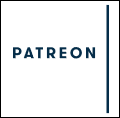
1 Gedanke zu “How Michael Moore’s anti-solar, anti-wind power and anti-electric car documentary does the climate movement a huge disservice”